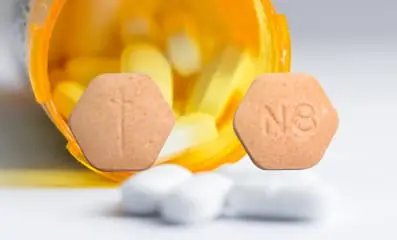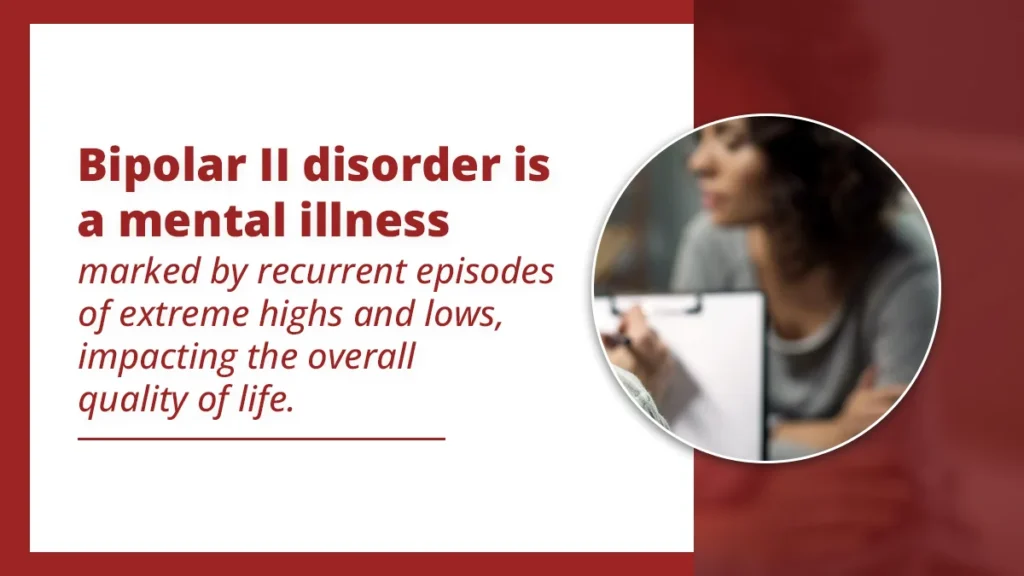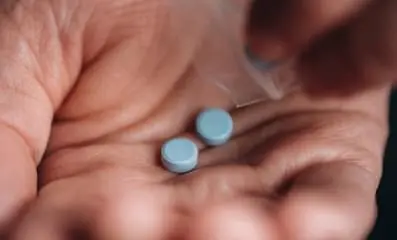
Bipolar 2 Disorder: Symptoms, Causes, and Treatments
Bipolar II disorder is a mental health condition where a person experiences extreme mood swings. These mood changes can range from periods of intense high energy and excitement (called hypomania) to episodes of deep sadness or hopelessness (known as depression).
These mood shifts can disrupt daily life, making it hard to focus, manage relationships, or keep up with responsibilities. Fortunately, effective treatments and coping strategies exist to help manage bipolar II disorder.
Key Takeaways
Bipolar II disorder is a mental health disorder characterized by intense mood changes. Here is what this article talks about:
- Bipolar II stems from a mix of different factors and can show up in the form of hypomanic and depressive symptoms.
- Accurate diagnosis by a healthcare provider is essential to ensure individuals receive appropriate treatment.
- With the right medical treatment and healthy self-care practices, individuals can break free from the grip of bipolar II disorder.
Contact Indiana Center for Recovery at (844) 650-0064 for comprehensive mental health care services in achieving mental wellness.

Bipolar II Disorder
Bipolar II disorder is a mood disorder characterized by periods of depressive episodes alternating with hypomanic episodes. It’s considered a subtype of bipolar disorder, formerly manic-depressive disorder, which involves unusual shifts in mood, energy, activity levels, and the ability to carry out day-to-day tasks.
Hypomanic Episodes
In bipolar II disorder, symptoms of hypomania may include:
- Increased energy and activity levels
- Racing thoughts
- Elevated mood or irritability
- Decreased need for sleep
- Increased talkativeness
- Increased goal-directed activity or agitation
- Poor judgment or engaging in risky behaviors (e.g., excessive spending, reckless driving)
- Grandiose beliefs or inflated self-esteem
Hypomanic episodes are less severe forms of full-blown manic episodes experienced in bipolar I disorder and may not cause significant impairment in functioning or require hospital care. However, they can still lead to issues in relationships, work, or other areas of life.
Depressive Episodes
In depressive episodes of bipolar II disorder, individuals may experience:
- Persistent feelings of sadness, hopelessness, or emptiness
- Loss of interest or liking in activities once enjoyed
- Significant changes in appetite, leading to body weight gain or loss
- Sleep disturbances (insomnia or excessive sleeping)
- Fatigue or loss of energy
- Feelings of worthlessness or excessive guilt
- Difficulty concentrating, making decisions, or remembering things
- Suicidal thoughts and ideations, or suicide attempts
Depressive episodes can be severe and may interfere with daily functioning, work, and relationships. It’s important to seek help from a health professional if you or someone you know is experiencing symptoms of bipolar disorder.
Underlying Causes of Bipolar II Disorder
The exact cause of bipolar disorder is not fully understood. However, numerous factors are believed to contribute to its development. These factors may include:
Genetic Factors
Genetics plays a significant role in bipolar II disorder. Research shows that individuals with a family history of bipolar disorder are more likely to develop the condition themselves. Genetic variations may affect how the brain regulates mood and energy levels, contributing to the onset of bipolar II.
Biological Factors
Imbalances in brain chemicals, like serotonin and dopamine, can contribute to bipolar II disorder. Structural changes in the brain’s regions involved in mood regulation may also play a role. These biological factors can influence the severity and frequency of mood swings experienced by individuals with bipolar II.
Psychological Factors
Psychological factors, such as stress, trauma, or major life changes, can trigger or exacerbate episodes of hypomania or depression in bipolar II disorder. In addition, personality traits like impulsivity or perfectionism may influence the course of the illness.
Environmental Factors
Environmental factors, including substance use disorders (SUDs), sleep issues, and inadequate support systems, can impact the onset and progression of bipolar II disorder. Exposure to stressful or traumatic events during childhood or adulthood may increase vulnerability to developing the condition.
Remember, bipolar II disorder is a complex and multifaceted condition, and the interplay of these factors varies from person to person.
Diagnosis of Bipolar II Disorder
Diagnosing bipolar II disorder involves a comprehensive assessment by a skilled mental health professional, usually a psychiatrist or psychologist. Here are some key steps and criteria they might use:
Clinical Assessment
Clinical assessment involves gathering information about the individual’s symptoms, medical history, and family history of mental disorders. A thorough evaluation helps clinicians understand the nature and severity of the symptoms experienced by the individual.
Diagnostic Criteria
The diagnosis of bipolar II disorder is based on specific criteria outlined in the Diagnostic and Statistical Manual of Mental Disorders (DSM-5). These criteria include experiencing at least one hypomanic episode and one major depressive episode, with distinct periods of mood disturbance.
Differential Diagnosis
Differential diagnosis is essential to differentiate bipolar II disorder from other conditions with similar symptoms, such as major depressive disorder (MDD) or cyclothymic disorder. Clinicians carefully consider the duration, frequency, and pattern of mood episodes to make an accurate diagnosis.
Assessment Tools
Various assessment tools, such as mood charts and questionnaires, may aid in diagnosing bipolar II disorder. These tools help track mood changes, bipolar symptoms, and treatment responses over time, providing valuable insights for doctors.
Treatment History
A thorough review of the individual’s treatment history, including past medication trials and therapy interventions, provides valuable insight into their response to previous treatments and informs current treatment planning.
Collateral Information
Collateral information from family members or close contacts may supplement the clinical assessment, providing additional perspectives on the individual’s symptoms and functioning.
By carefully assessing these factors, clinicians can accurately diagnose bipolar II and develop effective treatment plans.
Treatment Options for Bipolar II Disorder
Treatment for bipolar II disorder typically involves a combination of different approaches. The following treatment options are the most common ones:
Psychotherapy (Talk Therapy)
Psychotherapy is an essential component of bipolar II disorder treatment. It helps individuals understand their condition, develop coping skills, and manage mood swings effectively. Cognitive behavioral therapy (CBT) and interpersonal therapy (IPT) are commonly used approaches.
Medication
Medication plays a vital part in stabilizing mood and managing symptoms of bipolar II disorder. Mood-stabilizing medicines, such as lithium and lamotrigine, are often prescribed to prevent episodes of hypomania and depression. Antidepressants and antipsychotics may also be used in conjunction with mood stabilizers.
Family Therapy
Involving family members in therapy can provide valuable support and improve communication within the family unit. Family therapy helps educate loved ones about bipolar II disorder, reduce conflicts, and enhance coping strategies for both the individual with the condition and their family members.
Newer Treatments
Advances in medical research have led to the development of newer treatments for bipolar II disorder. These may include adjunctive therapies such as repetitive transcranial magnetic stimulation (rTMS) or electroconvulsive therapy (ECT) for patients who do not respond well to traditional treatments.
Individuals with different types of bipolar disorder need to work closely with mental health professionals to develop an individualized treatment plan tailored to their specific needs and circumstances.
Coping Strategies for Bipolar II Disorder
Living with bipolar II disorder can be challenging, but adopting effective coping strategies can help individuals manage their symptoms and boost their overall quality of life. Here are some of the practical approaches that can make a difference.
Medication Adherence
Consistently taking prescribed meds as directed by a healthcare provider is vital for managing bipolar II disorder effectively. Medications help stabilize mood swings and prevent episodes of hypomania or depression.
Continued Therapy
Engaging in ongoing therapy, such as individual or group counseling, provides valuable support and guidance for coping with bipolar II disorder. Therapy sessions offer opportunities to explore emotions, learn coping skills, and develop strategies for managing challenges.
Stress Reduction Techniques
Practicing stress reduction methods, such as deep breathing exercises, meditation, or yoga, can help manage stress and promote relaxation. These techniques can be particularly beneficial during periods of heightened mood or anxiety.
Healthy Lifestyle Changes
Maintaining a healthy lifestyle, including regular physical exercise, a balanced diet, and adequate sleep, can contribute to mood stability and overall well-being. Engaging in activities that improve physical and mental health is essential for managing bipolar II disorder.
Strong Support Network
Building a strong support network of family members, close friends, or support groups can provide invaluable support during difficult times. Having people to lean on and talk to can help individuals feel understood and supported.
Avoid Triggers
Identifying and avoiding triggers, such as stressful situations, sleep deprivation, or substance abuse, can help prevent mood episodes from occurring. Recognizing personal triggers and taking steps to minimize exposure to them is essential for managing bipolar II disorder.
Develop a Crisis Plan
Creating a crisis plan outlining steps to take during a mood episode or emergency can provide clarity and guidance for both the individual and their support network. Having a plan can help manage crises more effectively and reduce feelings of panic or helplessness.
Incorporating these strategies into everyday life can help those with bipolar II disorder effectively manage their condition and thrive.
Frequently Asked Questions (FAQ)
Living a normal life with bipolar II disorder is possible. With proper treatment, support, and coping strategies, individuals can manage their symptoms effectively and lead healthier lives.
How do they diagnose bipolar II?
Diagnosing bipolar II disorder involves clinical assessment, reviewing symptoms, and checking for criteria outlined in the DSM-5. It may include evaluating mood swings, duration, and family history and ruling out other conditions.
Living with bipolar II disorder brings ups and downs. In episodes of mania, you feel high and full of pep. But then come the depressive episodes, where you feel sad and low. Medications and therapy can help manage these mood shifts.
Bipolar II disorder symptoms include periods of hypomania with increased energy and excitement, followed by episodes of depression characterized by sadness, fatigue, and changes in sleep and appetite.



